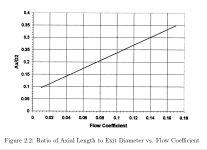Leiffi
New member
- Joined
- Jan 31, 2013
- Messages
- 1,381
Found an interesting study about effect of blade length. Seems like some racing turbo companies order their billet wheels with as long blades as possible without thinking anything, then advertise they flow more even if in real life they flow less than shorter blades.
Of course there are other factors for optimal blade length for intended use but it might be hard to decide optimal length without high tech testing facilities.
Another design feature that has attracted some attention from researchers is the axial length of the compressor which can also be described in terms of curvature. As discussed in Section 1.2.1, some portion of the pressure rise in the impeller comes from velocity pressure and some comes from diffusion within the channel. According to Al-Zubaidy, ”The so-called 50% reaction design strategy attempts to achieve approximately half the diffusion in the impeller and half in the diffuser. In modern literature the term ”diffusion ratio” (which is an indication of static pressure rise) is more widely used.” [19] In his mathematical study, Al-Zubaidy proposes that there is a ratio of axial length to outlet diameter (z/D2) that will produce optimum efficiency. This is due to the fact that a large value for z/D2 creates a short, wide channel that will cause over-diffusion and flow separation within the channel, but frictional effects become the dominant source of loss as channel length increases. An optimum efficiency band is found to be in the range of about 0.25 < z/D2 < 0.32 and the geometry of around 30 impeller designs is found to cluster in that range. In his book, Aungier proposes that the best value for z/D2 is dependent on flow coefficient and proposes a direct, linear relationship between flow coefficient and z/D2 as seen in Figure 2.2. [20] These proposals were tested by Sorokes et al. in a computational fluid dynamic study of the effect of shroud curvature (as a proxy for axial length) on impeller performance. A baseline design was modeled through z/D2 values ranging from 0.21 to 0.30 and the best performance was seen at a value of 0.30 for a flow coefficient of 0.12 [21] giving support to the findings of Al-Zubaidy and Aungier.
Of course there are other factors for optimal blade length for intended use but it might be hard to decide optimal length without high tech testing facilities.
Another design feature that has attracted some attention from researchers is the axial length of the compressor which can also be described in terms of curvature. As discussed in Section 1.2.1, some portion of the pressure rise in the impeller comes from velocity pressure and some comes from diffusion within the channel. According to Al-Zubaidy, ”The so-called 50% reaction design strategy attempts to achieve approximately half the diffusion in the impeller and half in the diffuser. In modern literature the term ”diffusion ratio” (which is an indication of static pressure rise) is more widely used.” [19] In his mathematical study, Al-Zubaidy proposes that there is a ratio of axial length to outlet diameter (z/D2) that will produce optimum efficiency. This is due to the fact that a large value for z/D2 creates a short, wide channel that will cause over-diffusion and flow separation within the channel, but frictional effects become the dominant source of loss as channel length increases. An optimum efficiency band is found to be in the range of about 0.25 < z/D2 < 0.32 and the geometry of around 30 impeller designs is found to cluster in that range. In his book, Aungier proposes that the best value for z/D2 is dependent on flow coefficient and proposes a direct, linear relationship between flow coefficient and z/D2 as seen in Figure 2.2. [20] These proposals were tested by Sorokes et al. in a computational fluid dynamic study of the effect of shroud curvature (as a proxy for axial length) on impeller performance. A baseline design was modeled through z/D2 values ranging from 0.21 to 0.30 and the best performance was seen at a value of 0.30 for a flow coefficient of 0.12 [21] giving support to the findings of Al-Zubaidy and Aungier.

